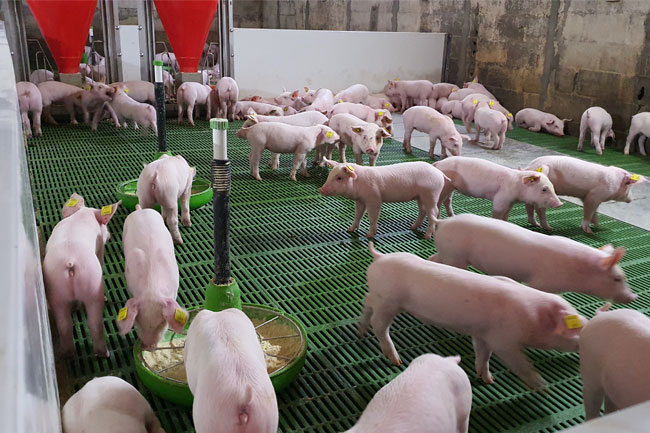Enfermedades, Prevención, Zona Porcino
Bivalentes vs. monovalentes: ¿qué vacunas protegen mejor frente a PCV2?

PCV2: un virus en constante evolución
El circovirus porcino tipo 2 (PCV2) es el responsable de una de las enfermedades más importantes en la producción porcina, afectando la salud de los animales y el rendimiento productivo. Las vacunas han sido clave para su control, pero la evolución del virus ha generado dudas sobre qué opción es más efectiva: ¿vacunas monovalentes, que protegen contra un solo genotipo, o bivalentes, que incluyen múltiples variantes?
PCV2 es un virus altamente variable, con múltiples genotipos identificados. Inicialmente, el genotipo predominante era PCV2a, pero con el tiempo, PCV2b y más recientemente PCV2d han ganado relevancia en diferentes regiones del mundo.
La vacunación con productos basados en PCV2a ha sido efectiva, pero estudios publicados sugieren que la protección es mayor cuando la vacuna y el virus están genéticamente más relacionados.[1,19] Esto ha impulsado el desarrollo de vacunas bivalentes, que combinan dos genotipos en una misma formulación
Diferencias entre vacunas monovalentes y bivalentes
Vacunas monovalentes: eficacia y limitaciones
Las vacunas monovalentes, en su mayoría basadas en PCV2a, han demostrado ser eficaces en la reducción de signos clínicos y la diseminación del virus. Sin embargo, su cobertura antigénica puede ser más limitada.
En un estudio reciente se ha observado una mejora biológicamente relevante, aunque no significativamente diferente, en la protección inducida por una vacuna monovalente basada en PCV2a frente a un desafío homólogo (PCV2a) respecto a un desafío heterólogo (PCV2b). Esto sugiere que la protección cruzada no es total[1].
Vacunas bivalentes: una cobertura antigénica más amplia
El suministro de vacunas bivalentes que combinan PCV2a y PCV2b ha mostrado:
- Una mayor cobertura antigénica en comparación con las monovalentes frente a virus PCV2 heterólogos, debido al solapamiento de epítopos para diversas cepas:[1]
- Un menor porcentaje de animales con viremia[1]
- Una disminución de la excreción fecal del virus[1]
Cabe deducir que estas características permiten reducir la propagación del virus en la granja y los signos clínicos de PCV2.
¿Cuál es la mejor opción para el control de PCV2?
Factores a considerar en la elección de la vacuna
A la hora de decidir qué vacuna utilizar, es importante tener en cuenta:
- Genotipos de PCV2 circulantes en la región: Si hay alta presencia de genotipos emergentes, una vacuna bivalente puede ser más efectiva.
- Cobertura antigénica: Si la presión de infección es alta y los genotipos son diversos, las vacunas bivalentes ofrecen una cobertura más amplia.
- Combinaciones con otras enfermedades: Algunas vacunas bivalentes incluyen protección contra PCV2 y Mycoplasma hyopneumoniae, optimizando el control sanitario en la granja.
Conclusión: ¿bivalente o monovalente?
Si bien las vacunas monovalentes han sido una herramienta efectiva para el control de PCV2, la evolución del virus ha hecho que su cobertura antigénica pueda verse reducida.[4,13, 16, 17, 18] En este contexto, las vacunas bivalentes han demostrado una mejor capacidad para inducir protección contra distintos genotipos y reducir la carga viral en los cerdos, lo que las convierte en una opción más robusta para enfrentar la variabilidad del virus.
La modernización de las vacunas es clave para garantizar una protección óptima y evitar pérdidas en la producción porcina. Ante la constante evolución de PCV2, optar por una vacuna combinada puede ser la mejor estrategia para asegurar la salud y el crecimiento de los cerdos.
Referencias
- Bandrick, M., Balasch, M., Heinz, A. et al. A bivalent porcine circovirus type 2 (PCV2), PCV2a-PCV2b, vaccine offers biologically superior protection compared to monovalent PCV2 vaccines. Vet Res 53, 12 (2022). https://doi.org/10.1186/s13567-022-01029-w
- Firth C, Charleston MA, Duffy S, Shapiro B, Homes EC (2009) Insights into the evolutionary history of an emerging livestock pathogen: porcine circovirus 2. J Virol 83:12813–12821
- Segalés J (2012) Porcine circovirus type 2 (PCV2) infections: clinical signs, pathology and laboratory diagnosis. Virus Res 164:10–19
- Franzo G, Segalés J (2018) Porcine circovirus 2 (PCV-2) genotype update and proposal of a new genotyping methodology. PLoS One 13:e0208585
- Gerber PF, Johnson J, Shen H, Striegel D, Xiao C-T, Halbur PG, Opriessnig T (2013) Association of concurrent porcine circovirus (PCV) 2a and 2b infection with PCV associated disease in vaccinated pigs. Res Vet Sci 95:775–781
- Franzo G, Cortey M, Segalés J, Hughes J, Drigo M (2016) Phylodynamic analysis of porcine circovirus type 2 reveals global waves of emerging genotypes and the circulation of recombinant forms. Mol Phylogenet Evol 100:269–280
- Saporiti V, Martorell S, Cruz TT, Klaumann F, Correa-Fiz F, Balasch M, Sibila M, Segales J (2020) Frequency of detection and phylogenetic analysis of porcine circovirus 3 (PCV-3) in healthy primiparous and multiparous sows and their mummified fetuses and stillborn. Pathogens 9:533–544
- Xiao CT, Halbur PG, Opriessnig T (2015) Global molecular genetic analysis of porcine circovirus type 2 (PCV2) sequences confirms the presence of four main PCV2 genotypes and reveals a rapid increase of PCV2d. J Gen Virol 96:1830–1841
- Xiao C-T, Harmon KM, Halbur PG, Opriessnig T (2016) PCV2d-2 is the predominant type of PCV2 DNA in pig samples collected in the U.S. during 2014–2016. Vet Microbiol 197:72–77
- Yang S, Yin S, Shang Y, Liu B, Yuan L, Zafar Khan MU, Liu X, Cai J (2017) Phylogenetic and genetic variation analyses of porcine circovirus type 2 isolated from China. Transbound Emerg Dis 65:e383–e392
- Opriessnig T, Xiao C-T, Gerber PF, Halbur PG (2013) Emergence of a novel mutant PCV2b variant associated with clinical PCVAD in two vaccinated pig farms in the U.S. concurrently infected with PPV2. Vet Microbiol 163:177–183
- Saha D, Lefebvre DJ, Huang L, Delputte PL, Van Doorsselaere J, Nauwynck HJ (2012) Single amino acid mutations in the capsid switch the neutralization phenotype of porcine circovirus 2. J Gen Virol 93:1548–1555
- Gava D, Serrao VHB, Fernandes LT, Cantao ME, Ciacci-Zanella JR, Mores N, Schaefer R (2018) Structure analysis of capsid protein of Porcine circovirus type 2 from pigs with systemic disease. Braz J Microbiol 49:351–357
- Lekcharoensuk P, Morozov I, Paul PS, Thangthumniyom N, Wajjawalku W, Meng XJ (2004) Epitope mapping of the major capsid protein of type 2 porcine circovirus (PCV2) by using chimeric PCV1 and PCV2. J Virol 78:8135–8145
- Krakowka S, Allan G, Ellis J, Hamberg A, Charreyre C, Kaufmann E, Brooks C, Meehan B (2012) A nine-base nucleotide sequence in the porcine circovirus type 2 (PCV2) nucleocapsid gene determines viral replication and virulence. Virus Res 164:90–99
- Saha D, Huang L, Bussalleu E, Lefebvre DJ, Fort M, Van Doorsselaere J, Nauwynck HJ (2012) Antigenic subtyping and epitopes’ competition analysis of porcine circovirus type 2 using monoclonal antibodies. Vet Microbiol 157:13–22
- Kurtz S, Grau-Roma L, Cortey M, Fort M, Rodríguez F, Sibila M, Segalés J (2014) Pigs naturally exposed to porcine circovirus type 2 (PCV2) generate antibody responses capable to neutralise PCV2 isolates of different genotypes and geographic origins. Vet Res 45:29
- Constans M, Ssemadaali M, Kolyvushko O, Ramamoorthy S (2015) Antigenic determinants of possible vaccine escape by porcine circovirus subtype 2b Viruses. Bioinform Biol Insights 9:1–12
- Karuppannan AK, Opriessnig T (2017) Porcine circovirus type 2 (PCV2) vaccines in the context of current molecular epidemiology. Viruses 9:99
- Opriessnig T, O’Neill K, Gerber PF, de Castro AMMG, Gimenéz-Lirola LG, Beach NM, Zhou L, Meng X-J, Wang C, Halbur PG (2013) A PCV2 vaccine based on genotype 2b is more effective than a 2a-based vaccine to protect against PCV2b or combined PCV2a/2b viremia in pigs with concurrent PCV2, PRRSV and PPV infection. Vaccine 31:487–494
- Reiner G, Hofmeister R, Willems H (2015) Genetic variability of porcine circovirus 2 (PCV2) field isolates from vaccinated and non-vaccinated pig herds in Germany. Vet Microbiol 180:41–48
- Franzo G, Tucciarone CM, Cecchinato M, Drigo M (2016) Porcine circovirus type 2 (PCV2) evolution before and after the vaccination introduction: A large scale epidemiological study. Nature Sci Rep 6:39458
- Alarcon P, Wieland B, Mateus ALP, Dewberry C (2014) Pig farmers’ perceptions, attitudes, influences and management of information in the decision-making process for disease control. Prev Vet Med 116:223–242
- Duffy S, Shackelton LA, Holmes EC (2008) Rates of evolutionary change in viruses: patterns and determinants. Nat Rev Genet 9:267–276
- Opriessnig T, Yu S, Gallup JM, Evans RB, Fenaux M, Pallares F, Thacker EL, Brockus CS, Ackerman MR, Thomas P, Meng XJ, Halbur PG (2003) Effect of vaccination with selective bacterins on conventional pigs infected with type 2 porcine circovirus. Vet Pathol 40:521–529
- SAS Institute Inc (2012) SAS/STAT User’s Guide Version 9.4. SAS Institute Inc, Cary
- Opriessnig T, Prickett JR, Madson DM, Shen H-G, Juhan NM, Pogranichniy RM, Meng XJ, Halbur PG (2010) Porcine circovirus type 2 (PCV2)-infection and re-inoculation with homologous or heterologous strains: virological, serological, pathological and clinical effects in growing pigs. Vet Res 41:31
- Beach NM, Ramamoorthy S, Opriessnig T, Wu SQ, Meng X-J (2011) Novel chimeric porcine circovirus (PCV) with the capsid gene of the emerging PCV2b subtype cloned in the genomic backbone of the nonpathogenic PCV1 is attenuated in vivo and induces protective and cross-protective immunity against PCV2b and PCV2a subtype in pigs. Vaccine 29:221–232
- Sorden SD, Harms PA, Nawagitgul P, Cavanaugh D, Paul PS (1999) Development of a polyclonal-antibody-based immunohistochemical method for the detection of type 2 porcine circovirus in formalin-fixed, paraffin-embedded tissue. J Vet Diagn Invest 11:528–530
- Grau-Roma L, Hjulsager CK, Sibila M, Kristensen CS, López-Soria S, Enøe C, Casal J, Bøtner A, Nofrarías M, Bille-Hansen V, Fraile L, Baekbo P, Segalés J, Larsen LE (2009) Infection, excretion and seroconversion dynamics of porcine circovirus type 2 (PCV2) in pigs from post-weaning multisystemic wasting syndrome (PMWS) affected farms in Spain and Denmark. Vet Microbiol 135:272–282
- Mancera Gracia JC, Smutzer M, Taylor L, Balasch M, Bandrick M (2021) One dose of a novel vaccine containing two genotypes of porcine circovirus (PCV2a and PCV2b) and Mycoplasma hyopneumoniae conferred a duration of immunity of 23 weeks. Vaccines 9:834
- Bandrick M, Gutierrez AH, Desai P, Rincon G, Martin WD, Terry FE, De Groot AS, Foss DL (2020) T cell epitope content comparison (EpiCC) analysis demonstrates a bivalent PCV2 vaccine has greater T cell epitope overlap with field strains than monovalent PCV2 vaccines. Vet Immunol Immunopathol 223:110034
- Venegas-Vargas C, Taylor LP, Foss DL, Godbee TK, Philip R, Bandrick M (2021) Cellular and humoral immunity following vaccination with two different PCV2 vaccines (containing PCV2a or PCV2a/PCV2b) and challenge with virulent PCV2d. Vaccine 39:5615–5625
- Beach NM, Meng XJ (2012) Efficacy and future prospects of commercially available and experimental vaccines against porcine circovirus type 2 (PCV2). Virus Res 164:33–42
- Meng XJ (2013) Porcine circovirus type 2 (PCV2): pathogenesis and interaction with the immune system. Annu Rev Anim Biosci 1:43–64
- Opriessnig T, Xiao C-T, Gerber PF, Halbur PG, Matzinger SR, Meng X-J (2014) Mutant USA strain of porcine circovirus type 2 (mPCV2) exhibits similar virulence to the classical PCV2a and PCV2b strains in caesarean-derived, colostrum-deprived pigs. J Gen Virol 95:2495–2503
- Opriessnig T, Gerber PF, Xiao C-T, Halbur PG, Matzinger SR, Meng X-J (2014) Commercial PCV2a-based vaccines are effective in protecting naturally PCV2b-infected finisher pigs against experimental challenge with a 2012 mutant PCV2. Vaccine 32:4342–4348
- Segalés J (2015) Best practice and future challenges for vaccination against porcine circovirus type 2. Expert Rev Vaccines 14:473–487
- Ssemadaali MA, Ilha M, Ramamoorthy S (2015) Genetic diversity of porcine circovirus type 2 and implications for detection and control. Res Vet Sci 103:179–186




